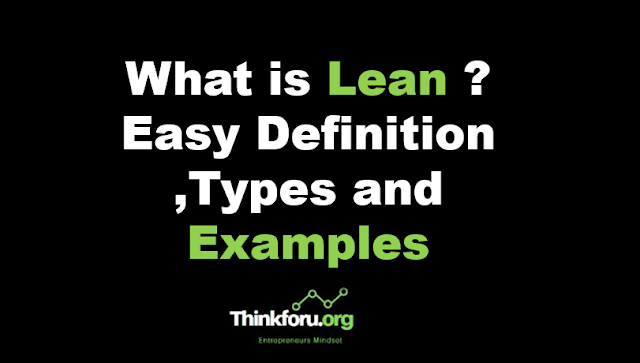What is Lean ? Easy Definition ,Types and Examples
What is Lean ? Easy Definition, Types, and Examples
 |
| What is Lean? Easy Definition, Types, and Examples |
"Lean" typically refers to a set of principles and practices aimed at maximizing value while minimizing waste in processes, often applied in the context of manufacturing, business operations, and product development. It originated from the Toyota Production System (TPS) and has since been widely adopted in various industries to improve efficiency, quality, and productivity.
Lean Easy Definition:
Lean is a methodology focused on eliminating waste and optimizing processes to deliver value more efficiently.
Types of Lean:
1. Lean Manufacturing: Applies lean principles to optimize manufacturing processes, reduce production lead times, and improve product quality by eliminating waste and improving flow.
2. Lean Six Sigma: Integrates lean principles with Six Sigma methodologies, combining efforts to reduce defects, improve quality, and increase efficiency in processes.
3. Lean Startup: Applies lean principles to startup companies and entrepreneurial ventures, emphasizing rapid experimentation, customer feedback, and iterative development to build products and services more efficiently.
4. Lean Construction: Adapts lean principles for the construction industry, aiming to minimize waste, improve project delivery times, and enhance collaboration among project stakeholders.
5. Lean Healthcare: Applies lean principles to healthcare organizations to optimize processes, reduce waiting times, improve patient flow, and enhance the overall quality of care.
6. Lean Office: Utilizes lean principles to streamline administrative processes, reduce paperwork, eliminate unnecessary tasks, and improve efficiency in office environments.
Examples of Lean:
Value Stream Mapping: Identifying and analyzing all steps and activities involved in delivering a product or service to customers, with the goal of identifying areas of waste and opportunities for improvement.
Just-in-Time (JIT) Production: Producing goods only when needed, in the quantities required, to minimize inventory costs and reduce the risk of overproduction.
Kaizen Events: Organizing focused improvement events or workshops, known as "Kaizen events," where cross-functional teams collaborate to solve specific problems, implement improvements, and drive continuous improvement.
5S Methodology: Implementing the 5S methodology (Sort, Set in Order, Shine, Standardize, Sustain) to organize the workplace, improve efficiency, and maintain a clean and organized work environment.
Kanban System: Implementing a visual management system, such as the Kanban system, to visualize workflow, track work progress, and identify bottlenecks in processes for better resource allocation and flow optimization.
These examples illustrate how lean principles and practices can be applied across different industries and domains to drive continuous improvement, reduce waste, and enhance overall performance and customer satisfaction.